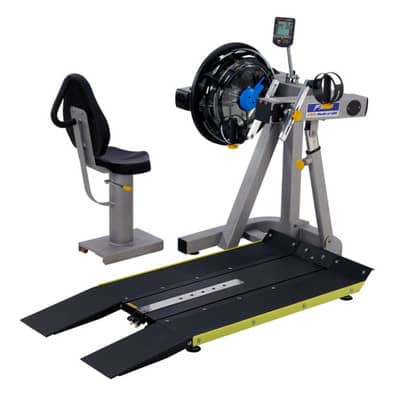Upper Body Ergometer
Build strength and fitness with the upper body ergometer
Classic ergometers are training bikes for the home or gym, but they leave out the upper body for the most part. The upper-body ergometer, on the other hand, offers the proven endurance training of the home trainer for the upper body as well.
-13%
BLACKWEEK
-{{UVPPercentDiscount}}%
new {{jahr}}
{{#UVP}} {{UVP}} {{/UVP}} {{record.Preis}}*
{{#FreeShipping}} free shipping {{/FreeShipping}} {{^FreeShipping}} excl. shipping costs {{/FreeShipping}}
{{^onStock}}Lieferzeit: {{/onStock}}{{record.Lieferbarkeit}}
- {{caption}}
- {{caption}}
- {{caption}}
- {{caption}}
- ...
- {{caption}}
- ...
- {{caption}}
- {{caption}}
- {{caption}}
- ...
- {{caption}}
- {{caption}}
- ...
- {{caption}}
- {{caption}}
- {{caption}}
- {{caption}}
Upper body ergometer - Targeted training for chest, arms and back.
Classic bicycle ergometers, cross trainers and treadmills have one thing in common: they focus on training the legs. Upper-body ergometers, on the other hand, are designed for targeted strengthening of the upper body. Although this makes them an exotic piece of fitness equipment, they offer unimagined potential for effective and sustainable training. Whether strength, endurance or cardiovascular training - everything is possible with a high-quality upper body ergometer.
What makes the upper-body ergometer
The basis of the upper-body ergometer is a stable seat. This enables an active sitting position. In this area, the upper body ergometers available on the market differ. While some have a backrest for safety as well as increased training comfort, models without a backrest promote active sitting. This means that in addition to the arm and shoulder muscles, the torso muscles are also actively involved in the workout, which results in passive strengthening. The heart of the upper-body ergometer is the crank, which works in the same way as a bicycle ergometer, but is only operated with the arms. The entire muscle chain is strengthened in a targeted manner through the space-gripping movements and the adjustable resistance. The focus can be deliberately placed on strengthening muscle power as well as strengthening the cardiovascular system to increase endurance. At the same time, the active sitting position strengthens the abdominal muscles, the lower back and the intercostal muscles.
When are upper-body ergometers used?
In principle, an upper-body ergometer is suitable for everyone. Especially those who want to strengthen the arm-shoulder area specifically for canoeing will benefit from a session on the special ergometer. But an upper-body ergometer is also much more suitable for warming up before an upper-body strength training session than a treadmill or bicycle ergometer. However, the sports equipment was developed specifically to meet the needs of people with walking disabilities as well as wheelchair users. Since the legs are not needed at all when using the device, the upper-body ergometer is an ideal way to do intensive endurance training. An upper-body ergometer for home use is also ideal for strengthening the upper-body muscles that are particularly stressed in the everyday lives of impaired people.
Water resistance offers optimal training conditions
Different resistance systems are used in training equipment. These are often belt drives or braking systems that work via eddy current and electromagnetic brakes. All these proven systems have their individual advantages and disadvantages. Particularly high-quality upper-body ergometers, on the other hand, are equipped with a braking system that works with water resistance. The use of water as a resistance mass ensures that there is a jerky change in resistance. This makes the workout particularly pleasant and promotes a natural development of strength. At the same time, in addition to reducing the risk of injury, it also reduces wear and tear on the braking mechanism.
Ideally plan training frequency and intensity
As with any piece of exercise equipment, the same principle applies to the upper-body ergometer: "Less is more!" Beginners in particular should not overdo it at the start so as not to overload their muscles and cardiovascular system. A good 15-20 minutes per day is absolutely sufficient. Much more important than the training itself, especially at the beginning, are sufficient rest periods in which the muscles can regenerate and then grow. If you have been training for a while, you can increase your training time per session to 30-60 minutes. However, there should still be at least 48 hours between two training sessions.
Get advice on upper-body ergometers now
Are you interested in upper body ergometers and training with these machines? You want to buy an upper body ergometer and have further questions about the features? You want to know more about a specific product? Then contact us now and ask us your questions directly on the phone or in writing via e-mail to info@fitstore24.com.

